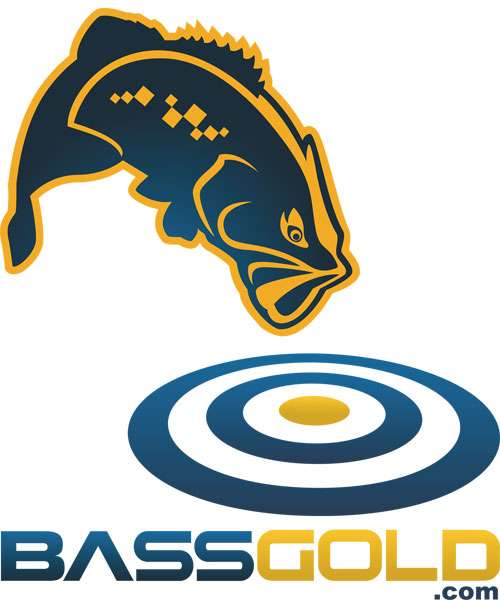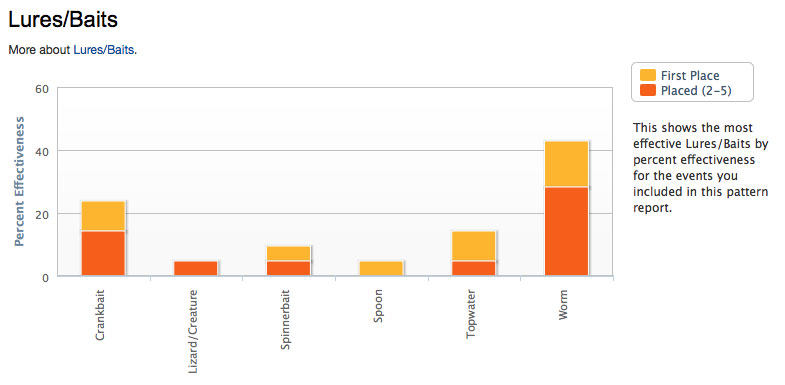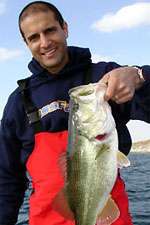
In preparation for this week’s 2012 Elite Series Power-Pole Slam on Lake Okeechobee, BassGold.com recently uploaded 80-plus patterns for Okeechobee tournaments. That brought the total to nearly 150 patterns on that lake, more than enough to take a look at Okeechobee in late spring.
As we’re doing before every Elite event, Ken Cook and I looked at what BassGold shows, and Ken gave his impression of how he’d fish the lake based on that data and his experience, both of which are key to getting the most out of BassGold.
Macro Factors
Macro Factors indicate that most tournaments this time of year are won in the BassGold categories “Canals” and “Main Lake Offshore Structure.”
The prevalence of canal patterns is interesting – especially in wins – but when you read BassGold’s tournament detail summaries, you see that the events in which canals were good were mostly (though not entirely) during the years when the lake was very low.
Right now, the water levels are a little low, so canals may be important to remember, particularly if looking for a non-herd pattern. But if Ken were fishing the tournament, he’d discard the canals’ importance. “Same for ‘Shoreline’ because that was most likely in a canal shoreline situation,” he said.
That leaves “Main Lake Offshore Structure” – meaning offshore grassbeds. “Structure” doesn’t usually mean grass, but in BassGold it can mean that when looking at a lake like Okeechobee. (The Habitat Factor info will clarify what “structure” means.)
“Offshore” means big parts of the lake – like the Monkey Box and South Bay, for example – not necessarily mid-lake. “I’d spend all my time looking for the winning fish in offshore grassbeds,” Ken said. “It’s always best to find good areas on both ends of the lake – north and south – because of the wind’s influence on water quality and fishability.”
Habitat Factors
It’s no surprise that the “Habitat Factor” graph indicates that “Submergent Veg,” meaning vegetation below the water’s surface, is responsible for 50 percent of Okeechobee wins and second-fifth finishes. The lake is one big grassbed!
For wins, the second-most-effective cover is “Emergent Veg” (vegetation that sticks up above the water) at 21 percent, but interestingly emergent vegetation only accounts for 7 percent of second-fifth finishes.
This indicates that doing something different isn’t consistent but can win. As Ken said, “Occasionally someone does well by flipping something like buggy whip reeds or cattails, but not often. That has a low chance of winning.”
When it comes to submergent vegetation, “the trick is figuring out what [grass] species or mix of species is holding the majority of the big bites,” he said. “I’ve found that seams between multiple species of vegetation are often the key to success.
“But it’s not as simple as looking for the vegetation. To zero in on a positive pattern, it’s necessary to narrow down the options even more, if possible. For instance, it might be holes in the hydrilla or eelgrass. You might target boat lanes or other linear openings. Or in a cold front, punching mats could be the deal.”
Lures/Baits

“Lures/Baits” is the name of the third category of bar graph in a BassGold Pattern Report, and in this case soft plastics dominate – as you’d expect in Florida and around vegetation. As Ken put it, “Soft plastics, especially long slender ones, seem to play well in south Florida lakes all the time, especially as the water gets warmer.”
Okeechobee should be on a warming trend, and we see that baits in the “Worm” category – including Senkos – are by far the most successful baits. But BassGold shows that a wide variety of lures have been used to finish first-fifth in Okeechobee tournaments this time of year. If worms or grass aren’t your thing, this might be valuable and confidence inducing information if you’re fishing a tournament there now.
But if you’re going with the probabilities, “The main thing is to be fishing a slow, feeding-type lure for bigger, winning-size fish,” Ken said. “BassGold shows that reaction lures do account for a big portion of successful patterns, but they’re best utilized as locating lures. Once a concentration of fish is found, an angler needs to slow down and target the bass that are normally grouped up at this season.”
The pattern detail summaries in the BassGold database show that most winners have used a combo of faster reaction lures followed up with slow presentations often involving Senko-type baits.
Spawners?
On the one hand, it seems a little late for spawners to play a big part on Okeechobee. On the other hand, three things: The mild winter seems to have paradoxically stretched out the spawning season in Florida; Alton Jones just won on the St. Johns River by sight fishing for spawners; and BassGold does show that 7.14 percent of winners incorporated “Spawning Beds” in their patterns on Okeechobee this time of year.
Ken noted that with the warm water temps now, “big females won’t be on a bed much during daylight, and certainly not for multiple days. So if an angler finds a big one, he needs to catch it right then, not wait ‘til tomorrow.”
Weight
What will it take to win at Okeechobee? The historical data in BassGold show an average of 20-plus pounds per day.
More Gold
Few things to remember:
- Note most waters in Florida fall under the “Natural Lake/River” water type in BassGold. That means they all fish somewhat similarly. From looking at data on Okeechobee, it seems that Florida – this time of year, anyway – is much more about spot and bait than about pattern.
- While part of the “gold” in BassGold is the information itself – the data display and having decades of pattern details right at your fingertips – there’s more gold to be mined in how you interpret the data using your fishing knowledge and experience.
- When you give BassGold.com a try, if you don’t see your favorite lake in there yet, remember two things. One is that you can search by “Water Type” (natural lake/river, upland reservoir, tidal, etc.), which is often Ken’s favorite way to use BassGold because he gets a wider data set that way. And two, BassGold is also set up to be the world’s best fishing log. Upload your own patterns or patterns from a newspaper or website – they don’t have to be from tournaments – and keep them private if you want.





